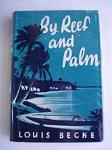

John Barrington takes a berth as a second mate to return to the Caroline Islands, where he left his Islander wife two years before. The ship is carrying three passengers, a missionary and his wife and her sister. The missionary, Parker, and his wife knew Barrington previously and Mrs Parker is secretly in love with him.
Barrington's wife, Nadee, is waiting for him on the island of Losap with her grandmother, who hates Europeans and endeavours to convince Nadee that Barrington will not return. When he does reach the island, in dramatic circumstances, a misunderstanding is deliberately perpetuated and tragedy ensues.
Becke also uses this narrative to put forward vitriolic views of missionaries and the harm he believes they cause.
'This chapter repositions the overlooked short stories of Australian-born author Louis Becke as a colonial experiment in archipelagic writing. By examining the stories as a collective, readers are able to view the South Seas of the colonial imagination as a networked vision defined by circulation and exchange. To this end, this chapter offers a reading of each of the stories of Becke’s first collection, By Reef and Palm (1894), allowing readers to construct a literary world. By shifting between story and anthology, the singular tale and the collective experience, Becke attempts to narrate the process of globalisation. By refusing to allow a single narrative or viewpoint to dominate the collection, Becke moves readers into a network of literature than can only be fully understood in an interdependent, transoceanic context.'
Source: Abstract.
This lecture is in some ways the ‘lost’ chapter of The Cambridge History of Australian Literature (2009), one eventually not written because the projected author could find not enough literary material even in that vast Pacific Ocean, or perhaps found – as mariners have – only far separated specks in that ocean. Yet Australian literature about the nation’s Pacific littoral and the islands within the ocean and the ocean itself is varied, considerable, and often eccentric. Our greatest drinking song is Barry Humphries’s ‘The Old Pacific Sea’. The Japs and the jungle are the hallmarks of fiction, poetry and reportage of the Pacific War of 1942-5. New Guinea has attracted such writers as James McAuley, Peter Ryan, Trevor Shearston, Randolph Stow and Drusilla Modjeska. The short stories of Louis Becke are the most extensive and iconoclastic writing about the Pacific by any Australian. Yet the literature of the Pacific littoral seems thinner than that of the Indian Ocean. The map on the title page of Rolf Boldrewood’s A Modern Buccaneer (1894) shows those afore-mentioned specks in a vast expanse of water. What aesthetic challenges have Pacific writing posed and how have they been met? Have the waters of the Pacific satisfied Australians as a near offshore playground but defeated wider efforts of the imagination? ' (Publication summary)
 Writing the Colonial Adventure : Race, Gender and Nation in Anglo-Australian Popular Fiction, 1875-1914
Oakleigh
:
Cambridge University Press
,
1995
Z480378
1995
single work
criticism
Writing the Colonial Adventure : Race, Gender and Nation in Anglo-Australian Popular Fiction, 1875-1914
Oakleigh
:
Cambridge University Press
,
1995
Z480378
1995
single work
criticism
'This book is an exploration of popular late nineteenth-century texts that show Australia - along with Africa, India and the Pacific Islands - to be a preferred site of imperial adventure. Focusing on the period from the advent of the new imperialism in the 1870s to the outbreak of World War I, Robert Dixon looks at a selection of British and Australian writers. Their books, he argues, offer insights into the construction of empire, masculinity, race, and Australian nationhood and identity. Writing the Colonial Adventure shows that the genre of adventure/romance was highly popular throughout this period. The book examines the variety of themes within their narrative form that captured many aspects of imperial ideology. In considering the broader ramifications of these works, Professor Dixon develops an original approach to popular fiction, both for its own sake and as a mode of cultural history.' (Introduction)